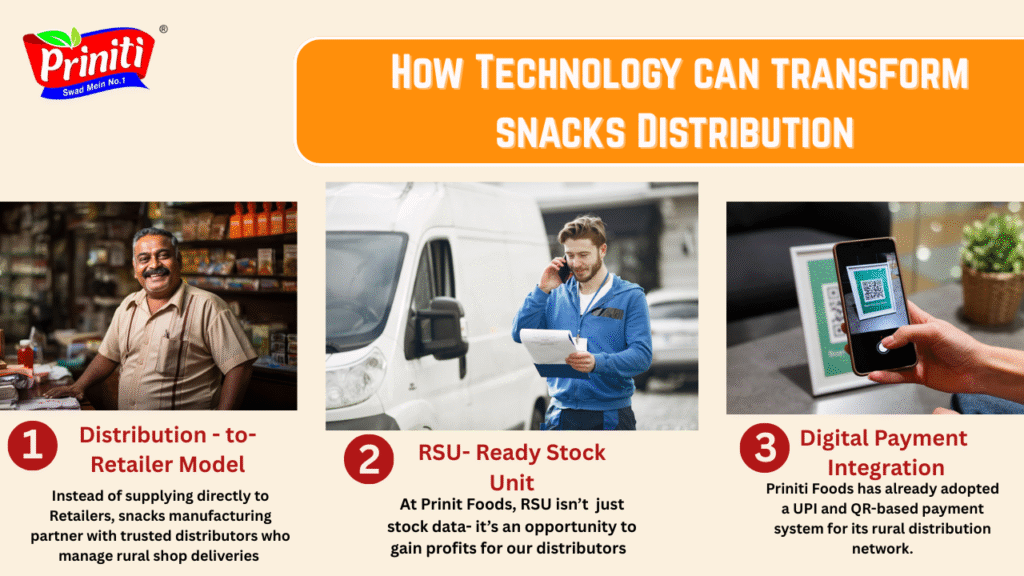
India’s Snack Industry Is Changing Fast — But Distribution Gap Is Still the Challenge
India’s snack industry is booming, yet rural markets remain under-served. Limited connectivity, high logistics costs, and fewer distributors create a distribution gap that delays product availability and reduces freshness.
Priniti Foods bridges this gap by combining distribution gap analysis, tech-driven supply chain management, and strong distributor partnerships. Our model ensures snacks reach even remote villages without compromising quality.
The Reality of Snack Distribution Gap in Rural India
Opportunity in the Gap
Many rural stores want to stock branded snacks, but struggle with irregular supply and higher prices due to logistics. For brands, this gap is a clear opportunity to grow market share.
Why the Traditional Model Struggles
The old system of regional distributors and manual order-taking is slow. It leads to stockouts, late deliveries, and reduced freshness for perishable items like sweets.
How Technology Can Transform Snack Distribution Gap
1. Distributor-to-Retailer Models
Instead of supplying directly to retailers, snack manufacturers partner with trusted distributors who manage rural shop deliveries. This ensures better coverage, consistent supply, and local relationship building.
2. RSU-Based Stock Planning
At Priniti Foods, RSU isn’t just stock data — it’s a premium service for our distributors. If a distributor opts for RSU, we assign a dedicated salesperson from our team to handle their sales planning, promotions, and market reach. This personalised support not only boosts the distributor’s sales but also strengthens our brand presence in their territory.
3. Digital Payment Integration
Priniti Foods has already adopted UPI and QR-based payment systems for its rural distribution network. This makes transactions faster, reduces cash-handling risks, and ensures smoother order processing for retailers. By going digital, we also reduce payment delays — keeping the financial gap between order and payment well-managed.
Emerging Trends in Closing the Snack Distribution Gap
- Hyperlocal Delivery Tie-ups: Partnering with local delivery services for last-mile connectivity.
- Affordable Rural Packs: Smaller, pocket-friendly snack packs designed for rural price sensitivity.
Rural Youth as Distribution Partners
Young entrepreneurs in villages are becoming micro-distributors, selling branded snacks through WhatsApp orders, local markets, and even small home-based stock points. This reduces delivery time and builds brand loyalty locally.
Challenges That Still Need Attention
- Cold Chain Needs: For sweets that require refrigeration.
- Internet Gaps: Poor connectivity limits app usage.
- Cost Control: Balancing affordable pricing with quality ingredients.
Conclusion:
The snack industry can close the rural distribution gap with the right mix of distribution gap analysis, tech-enabled distribution management, and customer-focused distribution services. Priniti Foods is committed to bridging this gap by ensuring that even the most remote markets get timely access to a wide range of fresh, high-quality snacks — from crispy namkeen to delightful sweets.
Rural India is ready for variety, freshness, and quality — and Priniti Foods is ready to deliver.
FAQs:
Q1. Why is rural snack distribution challenging?
Limited connectivity, high logistics cost, and fewer distributors.
Q2. Can technology improve rural snack supply?
Yes — through direct ordering apps, GPS delivery, and digital payments.
Q3. Which snacks sell most in rural markets?
Namkeen, chips, fryums, cookies, and affordable sweets.
Q4. What’s the biggest growth opportunity?
Reaching untapped villages with fresh, branded snack products.
Q5. How is Priniti Foods improving rural snack distribution?
By partnering with local distributors, following RSU-based stock planning, and using tech-driven delivery systems, Priniti Foods ensures that rural markets receive fresh snacks quickly and efficiently.
